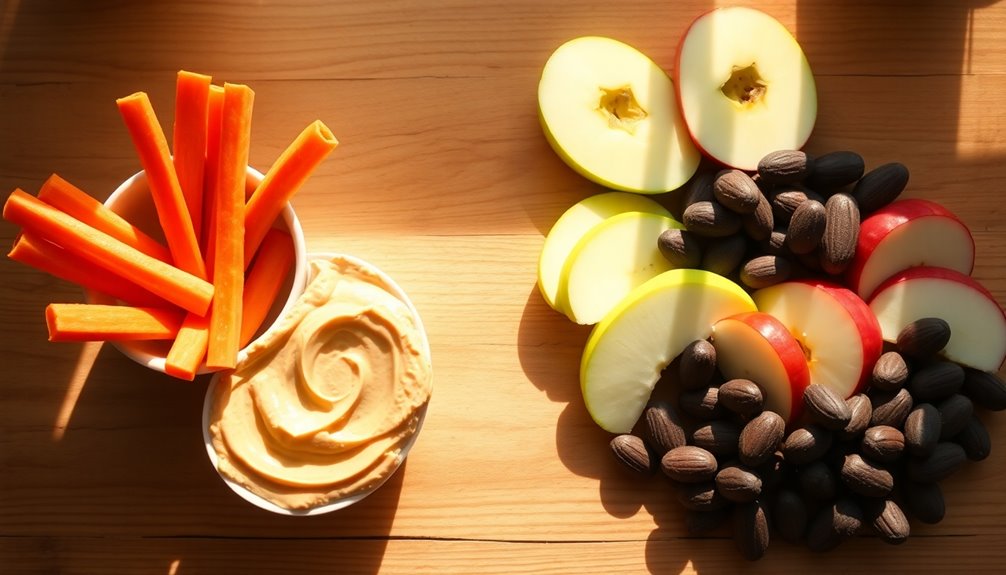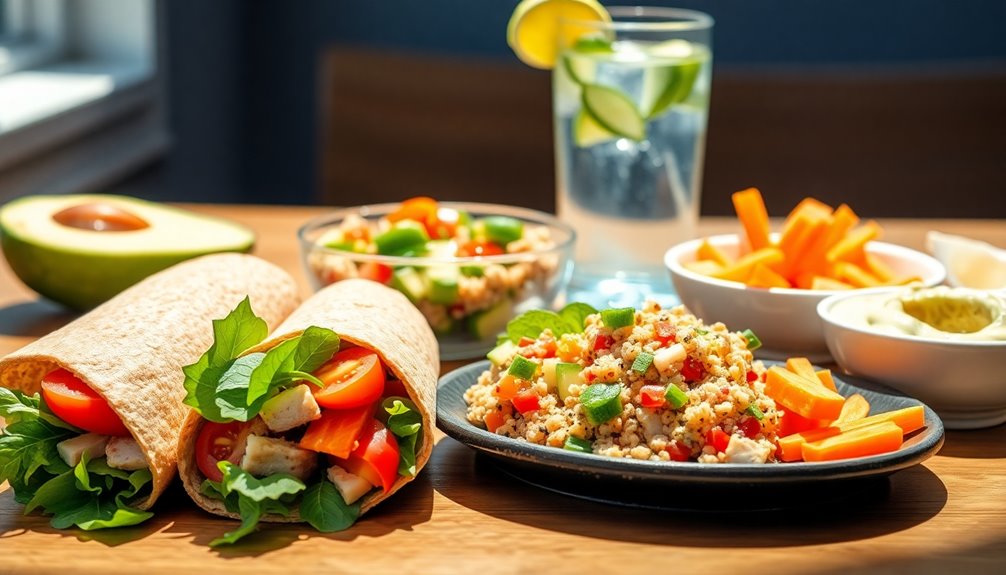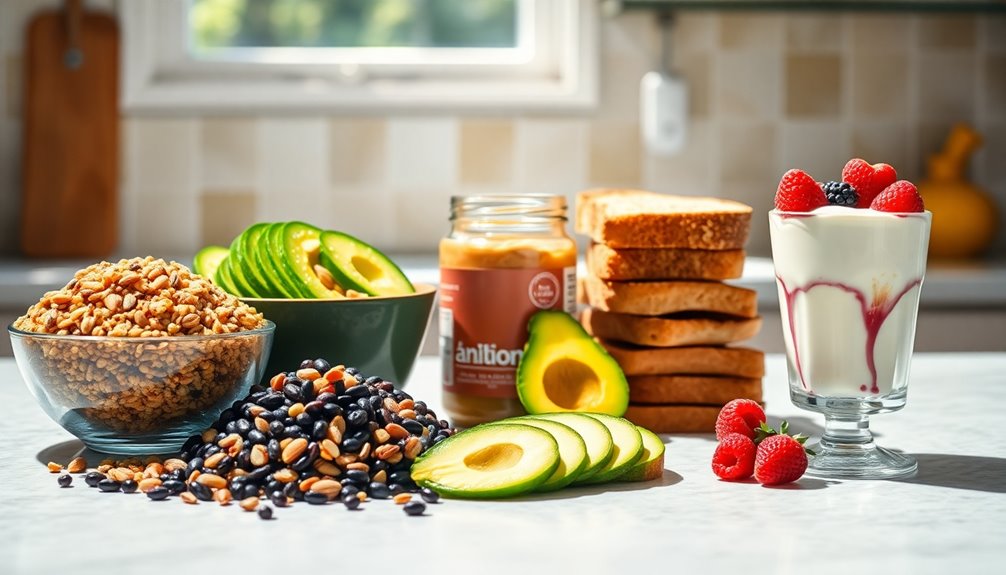Making simple swaps in your diet can significantly boost your macronutrient intake. Start your day with a breakfast bowl or overnight oats instead of sugary cereals. Snack on Greek yogurt with fruit, nuts, or veggies with hummus. For lunch, choose whole grain sandwiches or salads packed with legumes. At dinner, swap white rice for quinoa and use Greek yogurt as a healthy sour cream alternative. Opt for olive oil or avocado oil in cooking. Finally, replace high-calorie desserts with fruit sorbet or Greek frozen yogurt. There's plenty more to explore to enhance your meals and health!
Key Takeaways
- Swap white rice for quinoa to increase fiber and protein content in meals.
- Replace sour cream with Greek yogurt for a healthier, protein-rich alternative.
- Choose whole grain bread over white bread to boost fiber and nutrient intake.
- Use avocado oil or olive oil instead of butter for heart-healthy fat options.
- Opt for fruit with nut butter instead of sugary snacks for balanced energy and healthy fats.
Upgrade Your Breakfast Choices

Upgrade Your Breakfast Choices
Breakfast is often referred to as the most crucial meal of the day, and for good reason. What you eat in the morning can set the tone for your entire day. Upgrading your breakfast choices can greatly enhance your macronutrient intake, helping you feel energized and focused.
One simple way to elevate your breakfast is by opting for breakfast bowls. These bowls are customizable, allowing you to mix and match ingredients to suit your taste and nutritional needs. Start with a base like whole grains or Greek yogurt, then pile on toppings such as fresh fruits, nuts, seeds, and even a drizzle of honey. This combination not only makes your meal visually appealing but also ensures you're achieving a balanced intake of carbohydrates, protein, and healthy fats. Additionally, incorporating low-carb, anti-inflammatory foods can further enhance the health benefits of your breakfast.
Another fantastic option is overnight oats. Preparing these the night before saves you time in the morning and allows for endless creativity. Mix rolled oats with your choice of milk or yogurt, and add fruits, nuts, or spices like cinnamon. Let them soak overnight, and you'll wake up to a hearty, nutrient-rich meal that's ready to go.
Snack Smarter

When it comes to snacking, making smarter choices can greatly enhance your overall macronutrient intake. By focusing on nutrient density, you can satisfy your cravings while giving your body the fuel it needs. It's all about choosing snacks that pack a punch without tipping the scale on portion control.
Here are some simple swaps you might consider:
- Greek yogurt instead of regular yogurt: Greek yogurt is higher in protein and lower in sugar, making it a great option for a filling snack.
- Raw veggies with hummus instead of chips: This swap provides fiber and healthy fats, giving you sustained energy without empty calories.
- Nuts instead of candy: Nuts deliver healthy fats, protein, and essential nutrients, which can keep you feeling satisfied longer.
- Fruit with nut butter instead of sugary snacks: This combination offers a balance of natural sugars and healthy fats, perfect for a quick energy boost. Additionally, opting for whole food sources of protein can further enhance the nutritional value of your snacks.
Enhance Your Lunch Options

Lunchtime is an important opportunity to refuel your body and boost your macronutrient intake. By making simple swaps, you can transform your lunch into a nutrient-packed meal that fuels your day. Let's explore some practical options to enhance your lunch choices.
Start with salad variations. Instead of the standard leafy greens, try incorporating a variety of colorful vegetables, legumes, and healthy fats like avocado or nuts. Adding quinoa or chickpeas can increase your protein intake, making your salad more satisfying.
If you usually rely on sandwiches, consider some sandwich tweaks. Swap out white bread for whole grain or sprouted bread, and add lean proteins like turkey or hummus. You might also replace high-calorie spreads with mustard or a light yogurt-based dressing to cut down on unnecessary fats.
Bowl creations offer another great way to pack in nutrients. Layer your favorite grains, such as brown rice or farro, with protein sources like grilled chicken or tofu, and top it off with a mix of steamed or roasted vegetables. This method not only boosts your macronutrient intake but also allows you to experiment with flavors.
Lastly, explore wrap alternatives. Use lettuce leaves or whole grain tortillas instead of traditional wraps. Fill them with a mix of proteins, veggies, and a flavorful sauce for a satisfying meal that's easy to customize. Incorporating plant-based foods into your meals can significantly enhance your overall nutrient profile.
With these simple swaps, you can create delicious lunches that keep you energized and satisfied all day long.
Dinner Makeover

Your dinner plate is another prime opportunity to boost your macronutrient intake and support your overall health. By making a few simple swaps, you can transform your meals into nutrient powerhouses without sacrificing flavor or enjoyment.
Start by focusing on portion control. It's easy to overfill your plate, especially with dense foods. Aim for balanced portions that provide a variety of nutrients. Here are some effective ingredient substitutions to contemplate:
- Swap white rice for quinoa: Quinoa is higher in protein and fiber, keeping you fuller longer.
- Choose whole-grain pasta instead of regular pasta: Whole grains offer more nutrients and can help regulate blood sugar levels.
- Use Greek yogurt instead of sour cream: Greek yogurt has more protein and fewer calories, making it a creamy and nutritious alternative.
- Opt for baked or grilled proteins instead of fried: Baking or grilling reduces unhealthy fats while enhancing flavor.
Incorporating these swaps isn't just about improving macronutrient intake; it's also about fostering a sense of community and wellbeing during mealtime. When you gather around the table with family or friends, share these healthy choices and inspire each other. Remember, it's all about making gradual changes that fit into your lifestyle. Additionally, recognizing that natural calorie cycles can aid in achieving a lean and healthy body may further motivate your meal choices.
Healthy Cooking Oils

Choosing the right cooking oils can greatly impact your overall health and macronutrient intake. By making healthy swaps, you can enhance the nutritional quality of your meals. Traditional oils like vegetable oil or canola may not be the best choices for your cooking needs. Instead, consider oil alternatives that offer more health benefits and nutritious options.
Olive oil, for example, is rich in monounsaturated fats, which can help lower bad cholesterol levels and reduce the risk of heart disease. It's perfect for sautéing vegetables or drizzling over salads.
Another excellent choice is avocado oil, which boasts a high smoke point and is loaded with vitamins. It works well for frying, roasting, or even as a base for dressings.
Coconut oil has gained popularity, thanks to its unique flavor and medium-chain triglycerides, which may boost metabolism. However, moderation is key, as it's high in saturated fat.
For baking, consider using nut oils like almond or hazelnut oil, which add a delightful taste while providing essential nutrients.
When you make these healthy swaps, you're not just changing your cooking oil; you're embracing a lifestyle that prioritizes your health. Remember, the benefits of cooking oils extend beyond flavor—they can positively influence your overall well-being. So, take a moment to evaluate the oils in your pantry and opt for those that align with your health goals. Your body will thank you!
Protein-Packed Additions

Incorporating protein-packed additions into your meals can greatly enhance your macronutrient profile, complementing the healthy oils you've chosen. By elevating your protein intake, you'll not only support muscle growth but also improve satiety, helping you feel fuller for longer. Here are some simple and effective protein sources you can easily integrate into your daily meals:
- Greek Yogurt: This creamy staple is packed with protein and can be used in smoothies, as a base for dressings, or even enjoyed with fruit and nuts for a quick snack.
- Meat Substitutes: Options like tofu, tempeh, or seitan provide a fantastic protein boost for plant-based diets. You can easily substitute these in stir-fries or salads.
- Legumes: Beans, lentils, and chickpeas aren't only high in protein but also rich in fiber, making them a perfect addition to soups, stews, or salads.
- Nuts and Seeds: Incorporating almonds, chia seeds, or pumpkin seeds into your meals adds crunch and a protein punch. Sprinkle them on yogurt or blend them into smoothies.
Incorporating these protein sources can contribute to a well-rounded diet that aligns with a custom keto diet plan. Making these protein-packed additions isn't just about nourishment; it's about creating delicious meals that you can share with family and friends. Embracing these foods will help you feel a sense of belonging to a community focused on health and wellness.
Smart Beverage Swaps

Beverages play a pivotal role in your overall macronutrient intake, often overlooked in the quest for a balanced diet. Making smart beverage swaps can greatly enhance your nutrition and support your health goals.
For instance, instead of sugary sodas or fruit juices loaded with added sugar, consider sparkling water infused with fresh fruit. It's a revitalizing alternative that hydrates without the excess calories or sugar.
If you enjoy coffee or tea, try to minimize the use of creamers and sugars. Instead, explore sugar substitutes like stevia or monk fruit sweetener. These options add sweetness without the calories, allowing you to enjoy your favorite drinks while keeping your macronutrient balance in check.
Hydration hacks can also make a substantial difference. Opt for herbal teas or homemade iced teas sweetened with your chosen sugar substitute. They're flavorful and hydrating, plus they come with the added benefit of antioxidants.
If you're thinking about sports drinks, remember that many are high in sugar. Instead, mix your own electrolyte drink using water, a pinch of salt, and a splash of lemon or lime juice. This approach aligns well with the Keto diet benefits, as it supports hydration without unnecessary sugars.
Dessert Alternatives

When it comes to satisfying your sweet tooth, you don't have to sacrifice your macronutrient goals. Swapping traditional desserts for healthier options can keep your cravings in check while still enjoying something delicious. Here are some smart alternatives that can help you stay on track:
- Fruit Sorbet: Made from pureed fruit and a bit of sweetener, fruit sorbet is a invigorating way to indulge without the heavy calorie load of ice cream.
- Frozen Yogurt: Opt for low-fat or Greek frozen yogurt. It offers protein and probiotics, making it a guilt-free treat.
- No Bake Treats: Whip up no bake treats using oats, nut butter, and honey. They're simple to prepare and provide a good balance of carbs and healthy fats.
- Homemade Smoothies: Blend your favorite fruits with spinach or protein powder for a nutrient-packed dessert that tastes indulgent.
Incorporating these alternatives can help mitigate the negative effects of traditional desserts on health, especially considering that high-carb options can lead to blood sugar spikes. These alternatives not only satisfy your cravings but also support your nutritional needs. By making these simple swaps, you can enjoy a variety of flavors and textures without compromising your health goals.
You're not alone on this journey; many are discovering that healthier desserts can be just as satisfying as traditional options. So, the next time you're tempted by sugary snacks, remember there are plenty of delicious and nutritious choices waiting for you.
Frequently Asked Questions
How Can I Track My Macronutrient Intake Effectively?
To track your macronutrient intake effectively, start by meal prepping each week. By planning your meals, you can control your portions and know exactly what you're eating.
Keep a food diary to record everything you consume; this helps you visualize your intake and identify patterns.
Use apps or online tools that calculate macronutrients automatically, making it easier to stay on track.
With consistency, you'll feel more connected to your nutritional goals and progress.
What Are the Benefits of a Balanced Macronutrient Ratio?
You might've noticed how your energy dips after certain meals. That's where balanced macronutrient ratios come into play. When you maintain a proper macronutrient balance, you not only boost your energy levels but also support weight loss effectively.
Research shows that a well-rounded intake of proteins, fats, and carbohydrates enhances overall health. By prioritizing these ratios, you'll feel more satisfied and connected to your body's needs, promoting a sense of belonging in your wellness journey.
Can I Still Enjoy My Favorite Foods While Swapping Ingredients?
Absolutely, you can still enjoy your favorite foods while making ingredient alternatives. By exploring recipe modifications, you'll find creative ways to swap out less nutritious ingredients for healthier options without sacrificing flavor.
For instance, using Greek yogurt instead of sour cream or whole grain flour instead of white can enhance your meals. These adjustments can satisfy your cravings, support your health goals, and help you feel more connected to your dietary choices. Enjoy the process!
How Do I Know if I Need More Protein or Carbs?
You might find yourself wondering if you need more protein or carbs after a workout or when you're feeling sluggish. Conducting a dietary assessment can help you identify your needs. Pay attention to your energy levels, muscle recovery, and overall well-being.
If you're unsure, seeking nutritional guidance from a professional can clarify your intake goals. Remember, everyone's body is different, and it's all about finding what works best for you.
Are There Any Apps to Help With Macronutrient Planning?
If you're looking for apps to assist with macro tracking, you're in luck! Popular options like MyFitnessPal and Cronometer can help you achieve nutrient balance by allowing you to log your food intake and see your macronutrient breakdown.
These apps often include features for setting goals based on your personal needs, making it easier for you to stay on track. Finding the right app can really enhance your nutrition journey!
Conclusion
By making simple swaps in your meals and snacks, you can greatly enhance your macronutrient intake and overall health. Did you know that studies show a diet rich in whole foods can reduce the risk of chronic diseases by up to 40%? It's a compelling reason to rethink your food choices. Remember, small changes can lead to big results. So, start incorporating these tips today, and watch your energy levels and well-being soar!



